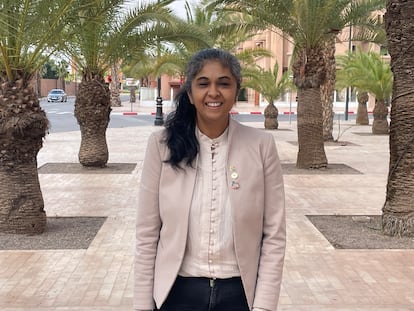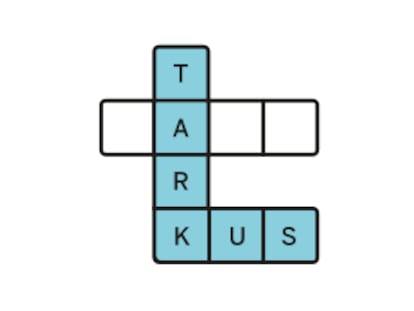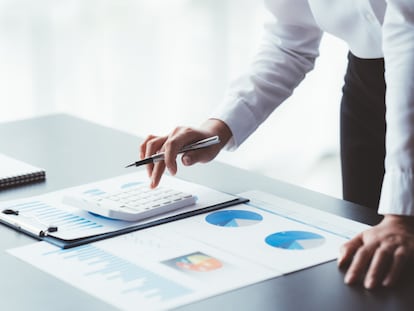How the US is turning into a mass techno-surveillance state
President Trump and his former star advisor, Elon Musk, have accelerated the deployment of a vast technological infrastructure that monitors the lives of millions of people. The system is focusing on immigrants — for now

Massive unauthorized scanning of social media. Analysis of biometric, income, health, and Social Security data. Interception of telephone communications. Geolocation via mobile devices. Tracking of car journeys using license plate readers. Since Donald Trump returned to the White House, the U.S. government has been using these and other tools based on artificial intelligence (AI) to monitor and persecute thousands of people without judicial authorization — mostly immigrants, foreigners passing through, or students. In the last four months, Trump and his former star advisor, the tech tycoon Elon Musk, have, along with the private sector, accelerated the deployment of a massive techno-surveillance state. And for the first time in history, Washington is boasting about it rather than denying its existence.
“Surveillance in the U.S. didn’t begin with Trump, nor will it end when he leaves the White House. The foundations for the current state of techno-surveillance were laid over decades, with bipartisan support for policies that normalized invasive practices in law enforcement, the military, and border control,” says the Bahraini civil rights activist Esra’a Al Shafei, who has been studying this issue for years, in a conversation with EL PAÍS. “This system is fueled by large budgets allocated to intelligence agencies, as well as private providers, all under the pretext of national security and crime prevention.” Companies like Palantir, Anduril, and GEO Group are providing Washington with digital tools to build this entire surveillance infrastructure.
Trump continues to add layers to this system. The Department of Homeland Security (DHS) confirmed in April that it is using a tool called Babel X to collect social media information about travelers who may be subject to increased surveillance, according to the agency itself. Immigration and Customs Enforcement (ICE), for its part, has acknowledged using another program, SocialNet, which aggregates data from more than 200 sources, including Facebook, Twitter/X, Instagram, LinkedIn, and dating apps.
Washington officially recognizes that simply finding “antisemitic activity” on feeds, such as protesting the massacre in Gaza, is enough for authorities to deny asylum or citizenship. U.S. officials are also being encouraged to report their colleagues if they detect any “anti-Christian bias,” according to an executive order signed by Trump in February. “Using social media surveillance to intimidate, harass, alienate, deport, imprison, or arrest is antithetical to many of the principles on which democracy is founded,” warned Paromita Shah, executive director of the U.S. immigrant advocacy NGO Just Futures Law.
Social media is just the surface. To feed this automated machine for tracking suspects, quality data about citizens is needed. Some of this information is being obtained by purchasing it from large data brokers, such as Thomson Reuters or Lexis Nexis, which create exhaustive profiles of millions of people, using up to 10,000 types of data about each individual based on their online trail. This ranges from their name, address, income level or where they shop, to their favorite types of leisure activities, the age at which their friends got married, their sexual history and emotional profile — all this information is available.
But the other part of that vast repository of data is being distilled within the federal government itself. This involves one of Trump’s signature projects and, until now, his star advisor, Elon Musk: the Department of Government Efficiency (DOGE), led by Musk himself, which has been amassing sensitive official data on hundreds of millions of citizens from other federal agencies for months, ranging from tax status to medical records. Some observers warn that this data may be taken by Musk now that he has decided to leave the White House.

The data collected by DOGE is being used by Palantir, which has over $2.7 billion in contracts with the administration, to build a new deportation platform for Immigration and Customs Enforcement, ImmigrationOS. It will serve to “support comprehensive analysis of target populations” and contribute to the individual tracking system, according to the contract summary, which specifies that the first prototype should be ready by September.
The tentacles of the techno-surveillance state are extensive. It processes data, but it also has eyes everywhere. “The infrastructure includes tools such as surveillance drones with facial recognition, biometric data collection, license plate readers, watchtowers equipped with high-resolution cameras and sensors, predictive policing tools, and location tracking, to name just a few,” says Al Shafei, founder of Surveillance Watch, an internationally renowned repository of information on companies involved in the business and known targets.
In recent months, the DHS has acquired several licenses for software used to spy on cell phones from Cellebrite, Paragon Solutions, Venntel, and NSO Group, the developers of the spyware Pegasus, according to data collected by Just Futures Law. This technology is used to access devices and see everything that happens on them, but there are also other tools for tracking cell phone locations. An investigation by Time magazine showed that women crossing state lines and approaching abortion clinics to terminate pregnancies have been identified in this way without a warrant.
Accelerated deployment
An analysis of the Department of Homeland Security’s AI use case inventory by Just Futures Law finds that at least 23 new AI technologies for customs enforcement have been registered in recent months. According to an investigation by The New York Times, the federal government has invested $7.8 billion since 2020 in immigration technologies, partnering with 263 companies to develop and deploy these tools.
Trump may not have invented techno-surveillance, but he has embraced it with a vengeance. “This process has happened extremely quickly. Trump has made it easier for Big Tech to do what they already wanted to do, but without any veneer of greenwashing or democracy,” Timnit Gebru tells this newspaper. The Ethiopian engineer was co-director of Google’s AI Ethics team until 2020, when she was fired shortly before publishing a scientific article describing how the algorithmic models underlying generative AI are heavily biased and harm minorities. A year later, she founded the DAIR Institute, where she researches the harm AI causes to the most vulnerable groups. “It’s really hard to keep up with what we’re learning. It’s terrible. And I don’t hear the Democratic Party talking about this,” she criticizes.
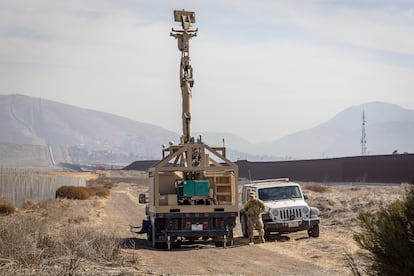
“Since Trump returned to the White House, the expansion of surveillance tools has accelerated, with policies that use data collection more aggressively than before,” Al Shafei said. “We are also seeing more requests for proposals from these government agencies seeking companies that can provide more invasive and sophisticated surveillance tools, so we can expect this trend to continue to expand.”
The victims of the system
This entire framework is being used with clear objectives. “These measures have disproportionately affected immigrants, refugees, students, and marginalized and low-income communities. Although the scale and intensity of surveillance are increasing, the problem is not new,” Al Shafei emphasizes.
No one is unaware of the implications of the machinery that Trump is polishing and oiling. A report prepared by several NGOs for the United Nations speaks of the “evaporation of human rights” in reference to what is happening at U.S. land borders. “A closer relationship between the government and surveillance companies, coupled with an intensification of surveillance in the U.S., represents a real threat to fundamental rights and freedoms,” says Michael De Dora, a researcher specializing in U.S. policy at the digital rights organization Access Now. “The Trump administration values national security above, or even at the expense of, human rights and privacy. Members of his administration are not only surveilling people, but have even discussed suspending fundamental democratic principles, such as habeas corpus.”
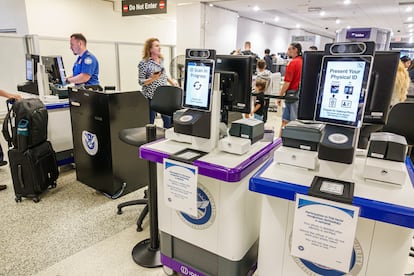
Europe is not immune to what’s happening in the U.S. “Agencies like Frontex and Europol are investing in biometric databases, facial recognition, and AI-based monitoring tools that closely resemble the systems already in place in the U.S.,” explains Aljosa Ajanovic, an analyst at the European Digital Rights Institute (EDRi).
Back in the U.S., many observers believe it is very difficult to limit the application of all these technological controls on foreigners. Not even the most staunch Trumpists, De Dora believes, should support the deployment of the techno-surveillance state. “Once this machinery is accepted and operational, it can be used against anyone.”
Sign up for our weekly newsletter to get more English-language news coverage from EL PAÍS USA Edition
Tu suscripción se está usando en otro dispositivo
¿Quieres añadir otro usuario a tu suscripción?
Si continúas leyendo en este dispositivo, no se podrá leer en el otro.
FlechaTu suscripción se está usando en otro dispositivo y solo puedes acceder a EL PAÍS desde un dispositivo a la vez.
Si quieres compartir tu cuenta, cambia tu suscripción a la modalidad Premium, así podrás añadir otro usuario. Cada uno accederá con su propia cuenta de email, lo que os permitirá personalizar vuestra experiencia en EL PAÍS.
¿Tienes una suscripción de empresa? Accede aquí para contratar más cuentas.
En el caso de no saber quién está usando tu cuenta, te recomendamos cambiar tu contraseña aquí.
Si decides continuar compartiendo tu cuenta, este mensaje se mostrará en tu dispositivo y en el de la otra persona que está usando tu cuenta de forma indefinida, afectando a tu experiencia de lectura. Puedes consultar aquí los términos y condiciones de la suscripción digital.
More information
Archived In
Últimas noticias
Most viewed
- Reinhard Genzel, Nobel laureate in physics: ‘One-minute videos will never give you the truth’
- Oona Chaplin: ‘I told James Cameron that I was living in a treehouse and starting a permaculture project with a friend’
- Pablo Escobar’s hippos: A serious environmental problem, 40 years on
- Why we lost the habit of sleeping in two segments and how that changed our sense of time
- Chevy Chase, the beloved comedian who was a monster off camera: ‘Not everyone hated him, just the people who’ve worked with him’


